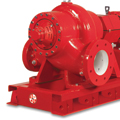Chicago’s Lurie Children’s Hospital blends innovative patient care and green technology.

Children’s Memorial Hospital of Chicago is one of the premier pediatric medical facilities in the country. On June 9, the hospital’s main facility moved downtown from the city’s north side and became the Ann & Robert H. Lurie Children’s Hospital of Chicago.
The move was made to the $1 billion, 23-story building to help the hospital further its mission to provide superior care to the region’s critically ill and injured children. The building design is of vital importance in helping the hospital fulfill its mission. Lurie Children’s Hospital incorporates not only green building design principles but also hospital design principles that increase patient safety, speed healing and make care more efficient.
It should come as no surprise then that only environmentally aware partners were invited to design and build the hospital’s new facility. Located on Northwestern University’s Feinberg School of Medicine campus, Lurie Children’s Hospital broke ground in April 2008. Consulting engineer Affiliated Engineers Inc. in Madison, Wis., and mechanical contractor F.E. Moran in Northbrook, Ill., selected pump manufacturer Xylem Inc. and manufacturers representative Bornquist Inc. in Chicago to assist them in developing the hospital’s HVACR systems.
“Hospitals are some of the most complex structures to design and build,” says Dave Everhart, sales manager at Bornquist. “Steam and water systems, disinfecting, HVAC systems, lighting, all must run 24/7, no matter what. Anything we can do to lower the hospital’s carbon footprint is always incorporated in our plans.”
Benefits and challenges
Making the design and construction of this particular hospital even more complex is its downtown location. The hospital’s new name recognizes philanthropist Ann Lurie’s $100 million gift, which enabled the move to the medical school campus.
The downtown location increases clinical, academic and research opportunities that lead to better care for children, according to the hospital. It also:
-
Helps the hospital recruit top pediatric specialists to Chicago;
-
Encourages child and adult health researchers to work more closely together;
-
Allows faster transport for critically ill newborns from Prentice Women’s Hospital, which is the largest birthing center in Illinois; and
- Improves transition of patients with chronic conditions into adult care at Northwestern Memorial Hospital and the Rehabilitation Institute of Chicago.
Along with these benefits, the downtown location brought challenges. Logistics to deliver and install some of the larger mechanical products had to be timed precisely in order to keep street closures and traffic disruptions to a minimum.
AEI specified several product lines of White Plains, N.Y.-based Xylem Inc. for the project. Bornquist had recommended to AEI the new Bell & Gossett VSX pumps, which feature innovative vertical split-case pump technology that enable the contractor to save significant space and money. Additionally, AEI specified Bell & Gossett heat exchangers and condensate pumps to provide a comprehensive system solution.
“B&G’s broad range of product and technology solutions enhanced our ability to win the job,” Everhart says.
Many of the pumps were so large, however, that the only way to install them was by crane. The city allowed the construction team a limited number of crane days when streets could be closed to make room for the equipment. The project’s timeline called for each day’s installation plan to run according to a tight schedule, Everhart says.
“When you’re constructing a state-of-the-art hospital that is designed to save children’s lives, there is no room for mistakes,” he notes.

Building green
The project was to be quoted as lean as possible, Everhart says, and Bornquist was able to save the engineer and project manager time and money. This became another key ingredient to winning the business.
Environmental impact also played a role in the hospital’s choice of Bell & Gossett and Bornquist for this project. B&G’s high-efficiency products keep pumping and water processes efficient and help the building reduce overall carbon emissions.
In addition, both companies are headquartered in the Chicago area so shipping logistics and transportation distances were minimal. This could help the hospital to qualify for LEED Gold-level certification from the U.S. Green Building Council.
The hospital features a host of other green initiatives including highly efficient plumbing fixtures and a storm-water management system. The hospital benefited from having some of the top subcontractors in the Chicago area, including more than 20 LEED-accredited professionals, working on the project.
On its website, AEI says it “brings a fundamental commitment to ensuring that our work reflects the highest standards in sustainable design practices. By supporting the sustainability-focused career development of our people, we support our clients with ongoing innovation in sustainable design.”
For its part, Bornquist’s early adoption of green building design principles is one reason that pme named the agency its 2007 Manufacturers Rep of the Year. We noted then that engineers may wish to rely on Bornquist’s expertise to properly achieve and apply the higher efficiency capabilities of equipment that was new to the market at that time.
“LEED (Leadership in Environmental and Energy Design) is primarily an architectural standard, but the mechanical systems are largely influenced by that standard,” Everhart stated in our 2007 article.
That’s still the case today, he says. What has changed in the last five years is that many more building owners, architects, engineers, contractors and wholesalers are familiar with LEED and high-efficiency products.
All the attention paid to efficiency during this project resulted in rigorous testing on B&G and other manufacturers’ products, Everhart says. Anything that would increase the HVACR system’s overall efficiency, such as installing independent control valves, was done as well.
The added value provided by Bornquist, along with B&G’s reputation for quality products, motivated the customer to recommend both companies to AEI.
“The contracting and engineering firms were meticulous in their product and service selection,” Everhart says. “We are very proud to be involved in this project.”
